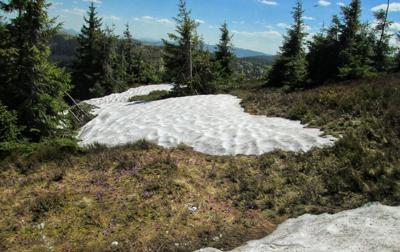Colorado's snowpack is dropping relatively fast this year compared to the norm, already at about 84 percent of what's normal for this point in the season. Keep in mind that around April 7 – which is when the snowpack peak of the season typically occurs on a statewide level, which was roughly the case this year – the statewide snowpack was at about 99 percent to 100 percent of the norm. In other words, despite this season being relatively standard in terms of snowpack, the snowpack has started dropping off at a faster-than-normal rate.
This steep drop-off becomes more obvious when looking at snowpack on a region-to-region basis. The San Miguel-Dolores-Animas-San Juan river basin in southwest Colorado, for example, was also at close to 100 percent of the norm when the typical peak snowpack date for the region of April 1 hit – it's since dropped to 68 percent of the norm for the date of April 25.

Snowpack in southwest Colorado. Graph: USDA.
The big question related to this steeper-than-normal snowpack drop-off is 'why.'
For starters, it's been warmer this April compared to most years in much of the state. And while some snowstorms have blown through, April hasn't brought the big totals that it does during some years. It's also worth noting that this warmer spring weather is expected to continue into mid-May.
And then there's a bigger issue – dust on snow. According to the Center for Snow and Avalanche Studies, dust severity has been pretty bad this snow season, with the presence of the dust on snow basically attracting more heat from sunlight and resulting in quicker melting. It's been a bad dust year, so a quicker snowmelt can be expected.
Another question to answer in regard to snowpack is 'when,' as in, when it will it be gone?
The USDA produces a graph that shows a variety of potential scenarios, some that assume a massive storm is about to hit and others that assume snowpack decline will continue at a similar rate.
If the current trend of warmer weather and not a ton of snow continues – and it's looking like it will, snowpack could be mostly depleted sometime between mid-May and the start of June. Even in a scenario where several big storms hit, snowpack is gone with a week left in June.

A projection of snowpack potentials in different scenarios. Graph: USDA.
So, there you have it, summer hiking season may be here sooner-than-later thanks to dusty snow and warm temperatures.
Follow along with updates on the USDA website.










(0) comments
Welcome to the discussion.
Log In
Keep it Clean. Please avoid obscene, vulgar, lewd, racist or sexually-oriented language.
PLEASE TURN OFF YOUR CAPS LOCK.
Don't Threaten. Threats of harming another person will not be tolerated.
Be Truthful. Don't knowingly lie about anyone or anything.
Be Nice. No racism, sexism or any sort of -ism that is degrading to another person.
Be Proactive. Use the 'Report' link on each comment to let us know of abusive posts.
Share with Us. We'd love to hear eyewitness accounts, the history behind an article.